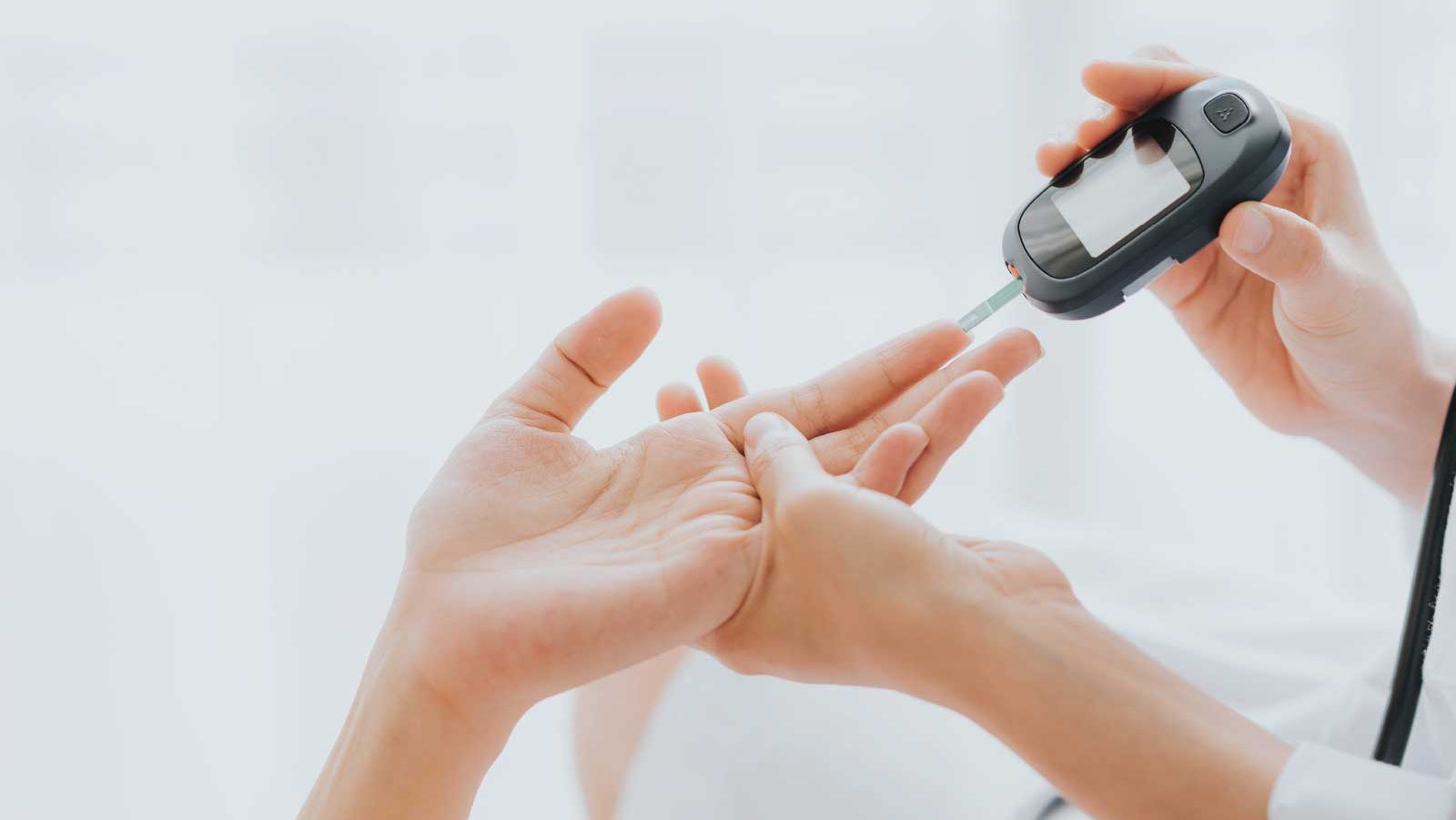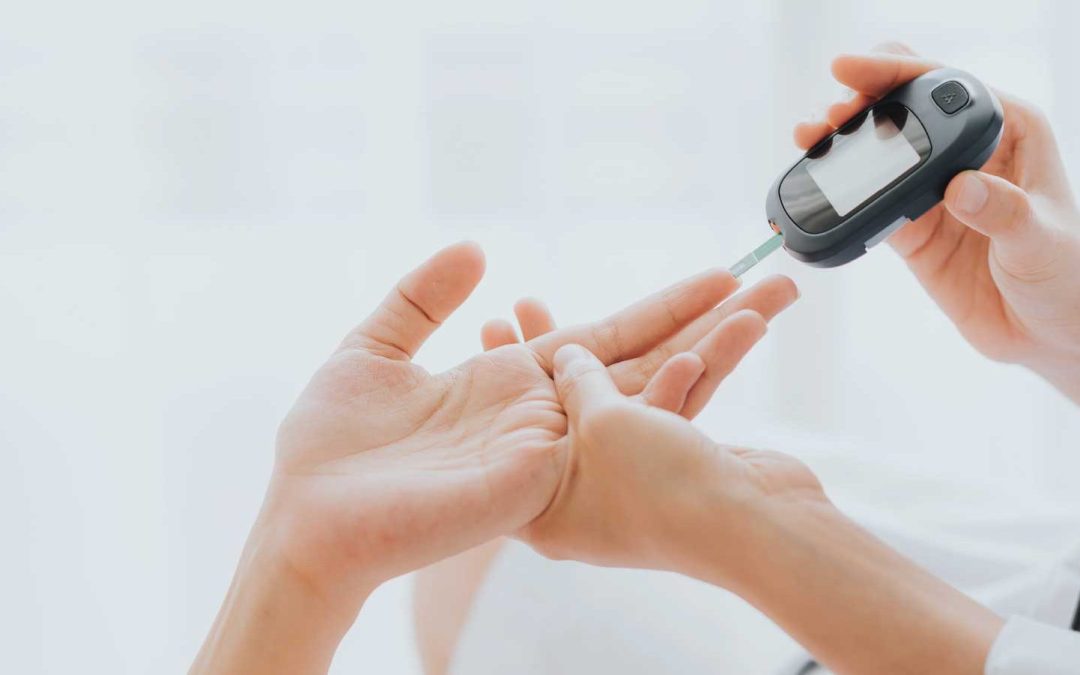November is Diabetes Action Month – a time to learn about the signs and symptoms of diabetes and how to take control of your health. From Continuous Glucose Monitors to knowing whether to get your blood sugar levels checked, we’ve covered some of the common questions that come up.

What are blood sugar levels?
Your blood sugar level (or blood glucose level) is the amount of sugar in your bloodstream. Glucose is broken down from the food you eat, it enters your blood stream, then is used by your cells as a primary source of energy. Insulin, which is produced by the pancreas, helps transport the glucose from the bloodstream into your cells to be used for energy.
Your blood sugar levels can be determined by different blood tests including the HbA1c test (which measures your average blood sugar levels over the past 2-3 months) or fasting blood glucose (which is your blood sugar levels after a period without eating) (1).
What is a Continuous Glucose Monitor (CGM) and who are they for?
A Continuous Glucose Monitor (CGM) is a small device that tracks your blood sugar levels. They are attached to your body (usually via the arm or stomach) and need to be replaced after ~10 days. Your blood sugar levels are provided in real-time by measuring the glucose levels in the interstitial fluid (fluid around your cells). This information is then able to be viewed via an App on your phone or computer.
These devices are designed for people living with diabetes to help them manage their condition and maintain their blood sugar levels within an appropriate range. In New Zealand they are currently funded for people with Type 1 Diabetes (2). They are not funded for people with Type 2 Diabetes and self-funding is expensive (around $300 per month) (3).
Why do people without pre-diabetes or type 2 diabetes use Continued Glucose Monitors (CGM’s)?
It is becoming more common for people to track their blood sugar levels and share their use of CGMs on social media. Often these people are generally healthy and have no clinical need to do so. Using a CGM for a period of time can provide really valuable insights into your individual responses to food and exercise. However, without adequate understanding there is a risk of becoming overly focused on the data or misinterpreting normal fluctuations, which may lead to unnecessary worry or concern.
For people without diabetes, blood sugar levels should not be the sole indicator of health. The range of normal blood sugar levels can differ between individuals, depending on age, activity levels, and other health conditions. Therefore, other health markers are important to consider. CGM’s are currently not recommended for people not living with diabetes or any risk factors, unless advised by a health professional. More research around the benefits of CGM’s for people without diabetes is needed.
Are blood sugar fluctuations normal?
Yes! Blood sugar fluctuations throughout the day are normal for people with and without diabetes. Stress, unbalanced meals, high intensity training, weightlifting, poor sleep are some of the reasons why blood sugar levels may peak during the day.
Whereas, aerobic exercise (walking, yoga), drinking alcohol, delaying meals, not eating enough carbohydrates, sickness, and dehydration can cause blood sugar levels to dip throughout the day. The Diabetes New Zealand website provides helpful information on the symptoms of high (hyperglycaemia) and low (hypoglycaemia) blood sugar levels and what to look out for.
Should I get my blood sugar levels checked?
You are unlikely to need to get your blood sugar levels checked unless you are experiencing one of the symptoms related to diabetes such as thirst, frequent urination, unexplained weight loss, feeling unusually tired, recurrent infections. If you are concerned about your health always talk to your GP or a health professional.
It is common to be recommended a blood test to check your blood sugar levels if a health professional wants to assess your metabolic health, you are at high risk of diabetes or if you fall into a certain group (i.e. pregnant women).

How can I keep my blood sugar levels in check?
There are lots of products and supplements which are marketed to “help you manage your blood sugar levels” and make you think you need them. However, the key to blood sugar management is focusing on an overall healthy and consistent diet and plenty of exercise (4).
Regular exercise can help lower your blood sugar levels over time. Movement increases your muscles’ uptake of sugar from the bloodstream for energy. This helps reduce post-meal blood sugar spikes and improves insulin sensitivity, allowing your body to manage blood sugar levels more effectively. Even a short 10–15 minute walk after a meal can make a noticeable difference.
It’s important to eat plenty of fibre-rich whole foods where possible, including;
- Fruit and vegetables (with the skins on)
- Legumes, nuts & seeds
- Wholegrains with the natural fibre structure intact like brown rice, quinoa, bulgur wheat
- Dairy foods like milk, yoghurt and cheese (reduced fat where possible)
- Lean protein foods like chicken, fish and meat
Focusing on whole foods will naturally lead to a reduction in processed foods and added sugar intake. Many whole foods are rich in fibre, a key nutrient for managing blood sugar levels and diabetes.
Learn more about the importance of Fibre and Diabetes.
Learn more about simple, healthy and delicious recipes to help you manage and prevent Type 2 diabetes: My Food Bag Diabetes Plan.

References:
- New Zealand Society for the Study of Diabetes. Glycaemic targets in the treatment of diabetes [Internet]. Type 2 Diabetes Management Guidelines; [cited 2025 Jul 8]. Available from: Glycaemic targets in the treatment of diabetes – New Zealand Society for the Study of Diabetes
- PHARMAC. Continuous glucose monitors (CGMs) [Internet]. New Zealand: Pharmac – Te Pātaka Whaioranga; [cited 2025 Jul 8]. Available from: Continuous glucose monitors (CGMs) – Pharmac | Te Pātaka Whaioranga | NZ Government
- Pharmac – Te Pātaka Whaioranga. Decision to fund continuous glucose monitors, insulin pumps, and insulin pump consumables [Internet]. 2024 Aug 29 [cited 2025 Jul 8]. Available from: Decision to fund continuous glucose monitors, insulin pumps, and insulin pump consumables – Pharmac | Te Pātaka Whaioranga | NZ Government
- The Diabetes and Nutrition Study Group (DNSG) of the European Association for the Study of Diabetes (EASD). Evidence-based European recommendations for the dietary management of diabetes. Diabetologia 66, 965–985 (2023). https://doi.org/10.1007/s00125-023-05894-8

